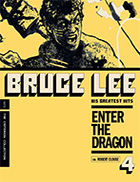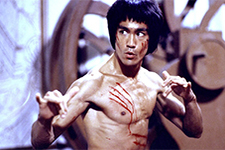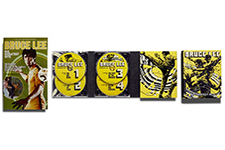| Director: Robert Clouse | | Screenplay: Michael Allin | | Stars: Bruce Lee (Lee), John Saxon (Roper), Jim Kelly (Williams), Ahna Capri (Tania), Kien Shih (Han), Robert Wall (Oharra), Angela Mao (Su Lin), Betty Chung (Mei Ling), Geoffrey Weeks (Braithwaite), Bolo Yeung (Bolo), Peter Archer (Parsons), Li-Jen Ho (Old Man), Marlene Clark (Secretary) | | MPAA Rating: R | | Year of Release: 1973 | | Country: U.S. / Hong Kong |  |
|  It is all there in the title, Enter the Dragon, which was originally supposed to be Blood and Steel or Han’s Island. But, Bruce Lee knew better. He knew that this was his moment, the one he had been working toward for more than a decade: a Hollywood-produced martial arts movie with him in the lead role. Lee’s Chinese stage name was Siu Loong, which means “Little Dragon,” so it only made sense that the film be titled Enter the Dragon because it was going to be the one that finally introduced him on a grand scale to Western audiences. It was his entrance, so to speak, and had he not died of a cerebral edemaone a month before the film’s release, its massive box office success would have secured him a solid cinematic future on both sides of the world. The plot in Enter the Dragon is an unabashed knock-off of the James Bond series and other international espionage thrillers. Lee stars as a martial artist named Lee who is recruited by British intelligence to infiltrate the island fortress of a drug runner and human trafficker named Han (Kien Shih), who holds an annual martial arts tournament there. There is little intrigue, as we know that Han is a bad guy and what he is up to, although director Robert Clouse tries to create some suspenseful scenes as Lee sneaks around the island at night, trying to find evidence of Han’s nefarious activities. The real action, though, is in the fight scenes, some of which involve Lee taking out Han’s guards and some of which involve the martial arts tournament itself. Lee’s physicality is duly impressive, as it was in his previous Hong Kong films, although by this point, he had perfected his screen persona, and his mythos is enhanced by a more protracted use of slow motion, which turns his leaps, kicks, and spins into super-human feats of balletic violence. And, while the film was shot on-location in Hong Kong (notably at the Palm Villa, a since redeveloped site on an island just off the coast), Warner Bros. was concerned that a Chinese-American actor couldn’t hold a film by himself, so they hedged their bets by giving us two additional protagonists: Roper (John Saxon) and Williams (Jim Kelly), both competitors at the tournament who have little purpose in the story other than to give white and black audiences on-screen faces. The film was made on an extremely tight budget, and most of the filmmakers were relatively young (and, most likely, inexpensive). Director Robert Clouse had helmed only two features before: Darker Than Amber (1970) and Dreams of Glass (1970), although he would go on to a long career directing low-budget action and martial arts films. Similarly, cinematographer Gil Hubbs had shot only a handful of features and some documentary shorts. The most experienced person in the production was composer Lalo Schifrin, who was famous at the time for composing the instantly memorable theme for the television series Mission: Impossible (1966–73), but had also recently written the music for major Hollywood films like Cool Hand Luke (1967), The Fox (1967)—both of which had netted him Oscar nominations—Coogan’s Bluff (1968), Bullitt (1968), and Dirty Harry (1971). Having been marginalized by the studios for years, relegated to a supporting character in the television series The Green Hornet (1966–67) and then denied the starring role in Kung Fu (1972–75), a series he had helped develop, Lee was all too aware of the xenophobia toward Asians in Hollywood, which is why he had spent the previous three years back in Hong Kong, establishing himself as a kung fu superstar in The Big Boss (1971), Fist of Fury (1972), and The Way of the Dragon (1972). Those films had gained him enough international recognition that Hollywood, specifically Warner Bros., had finally come calling, and Lee was prepared to make the most of it. He wanted to make, in his words in a letter he wrote to Ted Ashley, the chairman of Warner Bros., “the f—ingest action motion picture that has ever been made,” which he described as his “obsession.” But, the producers didn’t trust him, and they declined to make the script changes he had worked on so furiously (the original script was penned by first-time scribe Michael Allin, who went on to write the 1974 blaxploitation film Truck Turner and contribute to the campy 1980 Flash Gordon). Lee refused to walk on set for almost two weeks until the changes were implemented, particularly the addition of several scenes that conveyed the essence of Jeet Kune Do, the martial arts practice he founded. In short, Lee wanted to ensure that Enter the Dragon was not just a banal Hollywood production that exploited kung fu for action thrills, but was rather a vehicle for both himself as a performer and his philosophical worldview. Much of that, I suspect, was lost on Western audiences who were simply enthralled with Lee’s physical prowess and the exhilarating newness of the violence of kung fu, which Lee choreographed in painstaking detail and enhanced with his unique blend of aural shrieks and slow-motion grimaces. We might not remember every one of Lee’s kicks or spins or rapid-fire series of punches in detail, but we remember his intensity, his presence, his sheer vigor, which ran counter to so many of the racist assumptions about the Chinese in the West. Enter the Dragon not just upended those assumptions, but obliterated them, quickly creating in the U.S. a desire for more martial arts films that, unfortunately, devolved after Lee’s death into unmitigated formula and bargain-basement knock-offs. Lee achieved his dream of superstardom, but tragically did not live to experience it. | Enter the Dragon Criterion Collection Blu-ray |  Enter the Dragon is available as part of The Criterion Collection’s Bruce Lee: His Greatest Hits boxset, which also includes The Big Boss (1971), Fist of Fury (1972), The Way of the Dragon (1972), and Game of Death(1978). Enter the Dragon is available as part of The Criterion Collection’s Bruce Lee: His Greatest Hits boxset, which also includes The Big Boss (1971), Fist of Fury (1972), The Way of the Dragon (1972), and Game of Death(1978). | | Aspect Ratio | 2.35:1 (all films) | | Audio | Mandarin Chinese Linear PCM 1.0 monauralEnglish Linear PCM 1.0 monaural | | Subtitles | English | | Supplements | Audio commentary on The Big Boss by Bruce Lee expert Brandon BentleAudio commentaries on The Big Boss, Fist of Fury, The Way of the Dragon, and Game of Deathby Hong Kong film expert Mike LeederAudio commentary on the special-edition version of Enter the Dragon by producer Paul HellerHigh-definition presentation of Game of Death II, the 1981 sequel to Game of DeathGame of Death Redux, a new presentation of Lee’s original Game of Death footage, produced by Alan CanvanVideo interviews on all five films with Lee biographer Matthew PollyVideo interview with producer Andre Morgan about Golden HarvestVideo program about English-language dubbing with voice performers Michael Kaye and Vaughan SavidgeVideo interview with author Grady Hendrix about the “Bruceploitation” subgenre and a selection of Bruceploitation trailersBlood and Steel, a 2004 documentary about the making of Enter the DragonMultiple programs and documentaries about Lee’s life and philosophies, including Bruce Lee: The Man and the Legend (1973) and Bruce Lee: In His Own Words (1998) Video interview with Linda Lee Cadwell, Lee’s widowVideo interview with actor Jon T. BennVideo interview with actor Riki HashimotoVideo interview with actor Nora MiaoVideo interview with actor Jun KatsumuraVideo interview with actor Robert WallVideo interview with actor Yuen WahVideo interview with actor Tung WaiVideo interview with actor Simon YamVideo interview with director Clarence FokVideo interview with director Sammo HungVideo interview with director Wong JingAlternate opening credits and titles Alternate ending for The Big BossExtended scenes for The Big Boss“Bruce Lee: The Early Years” featurette“Bruce Lee vs. Peter Thomas” featurette The Legacy of the Dragon documentary “Bruce Lee Remembered” featurette The Grandmaster and the Dragon documentaryTrailers, TV spots, and radio spotsEssay by critic Jeff Chang | | Distributor | The Criterion Collection | | Release Date | July 14, 2020 | | | COMMENTS | | It may be hard to believe, but this is the first time all five of Bruce Lee’s starring vehicles have been collected into a single Blu-ray package, and Criterion has pulled out all the stops, giving us new high-definition transfers of all five films and hours upon hours of supplements that should keep even the most ravenous Bruce Lee fan satiated. Let’s start with the presentation of the films themselves: They were all transferred and restored in 4K, with the exception of the theatrical version of Enter the Dragon, which was done in 2K. The Big Boss and Fist of Fury were transferred from the original 35mm camera negatives, although the latter used a 35mm interpositive for the opening credits. The Way of the Dragon and Game of Death were transferred from 35mm internegatives, and Enter the Dragon was scanned from a 35mm interpositive. All of the films look better than they ever have on home video, as the new high-def transfers bring out additional levels of detail and texture that were missing in previous editions, as well as improved color timing that results in more natural looking flesh tones and stronger color saturation. Digital restoration has the films looking virtually flawless, with very few instances of dirt and wear. All in all, the films look great. The soundtracks were transferred from a variety of sources (including from materials held by a number of unnamed collectors), and while many of them (especially the early films) are certainly lacking in technical polish, they are reflective of the original aural experience and should be understood as such. And now, onto the supplements, which are … voluminous. How voluminous? Well, there are supplements on each of the discs for the five films and there are two separate Blu-rays just for supplements. I would be lying if I said I had watched and listened to every minute of it all, but I did get through a lot and would like to note some of the highlights. I really appreciated all of the audio commentaries. Each film features a track by Hong Kong film expert Mike Leeder. The Big Boss features an additional track by Bruce Lee expert Brandon Bentle, and the special edition version of Enter the Dragon features an additional track by producer Paul Heller. Each film also includes a video introduction by Matthew Polly, author of the recently published biography Bruce Lee: A Life and himself a practitioner of kung fu who was the first American to be allowed to study at the Shaolin Temple in China. There are hours of archival video interviews with Lee’s family and collaborators, including his widow Linda Lee Calwell and actors John T. Benn, Robert Wall, and Sammo Hung, among others. There are also some new interviews and programs, including a highly entertaining rundown on the Bruceploitation genre by author Grady Hendrix (along with 13 minutes of trailers for some of the more well-known Bruce Lee knock-offs), an engaging look at the history of Golden Harvest with producer Andre Morgan, and a fascinating program on dubbing the films into English with voice performers Michael Kaye and Vaughan Savidge. There are also multiple documentaries about Lee’s life and philosophies, including Bruce Lee: The Man and the Legend (1973), which weirdly and morbidly spends nearly half an hour on Lee’s death and funeral (all of the footage used in Game of Death appears here) and Bruce Lee: In His Own Words (1998). Other highlights include a high-definition presentation of Game of Death II, the 1981 sequel to Game of Death (not a good film by any means, but it is nice to have it hear for historical context) and Game of Death Redux, a new presentation of Lee’s original Game of Death footage produced by Alan Canvan. There are also alternate opening credits and titles for several films, as well as an alternate ending and extended scenes for The Big Boss. Throw in a making-of documentary about Enter the Dragon, a featurette on Bruce Lee’s early years, and tons of trailers, TV spots, and radio spots, and you have a package that can arguably be labeled as definitive. |
Copyright © 2021 James Kendrick Thoughts? E-mail James Kendrick All images copyright © The Criterion Collection |



 (3)
(3)

 Enter the Dragon is available as part of The Criterion Collection’s Bruce Lee: His Greatest Hits boxset, which also includes The Big Boss (1971), Fist of Fury (1972), The Way of the Dragon (1972), and Game of Death(1978).
Enter the Dragon is available as part of The Criterion Collection’s Bruce Lee: His Greatest Hits boxset, which also includes The Big Boss (1971), Fist of Fury (1972), The Way of the Dragon (1972), and Game of Death(1978). 